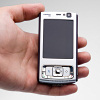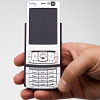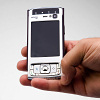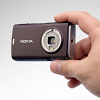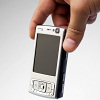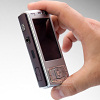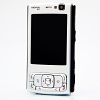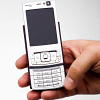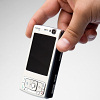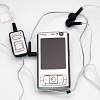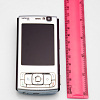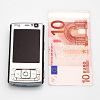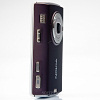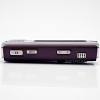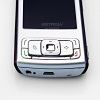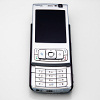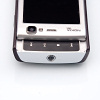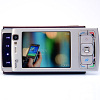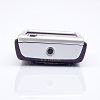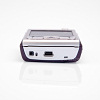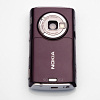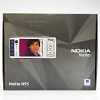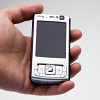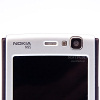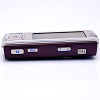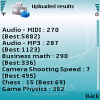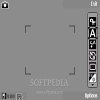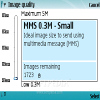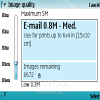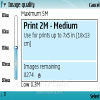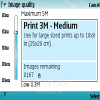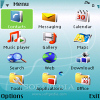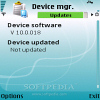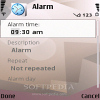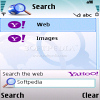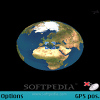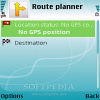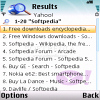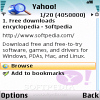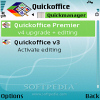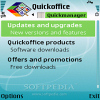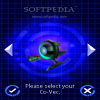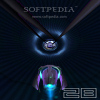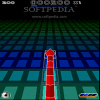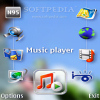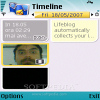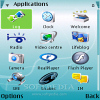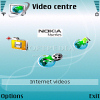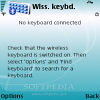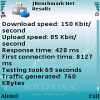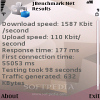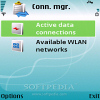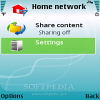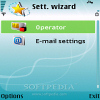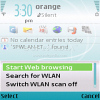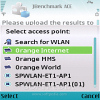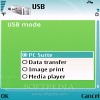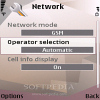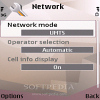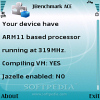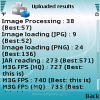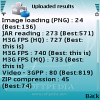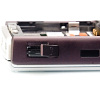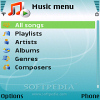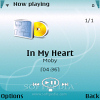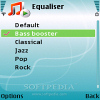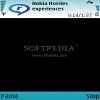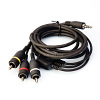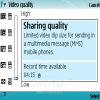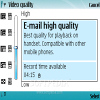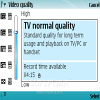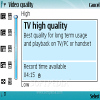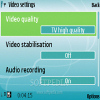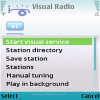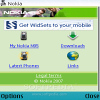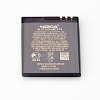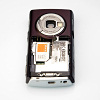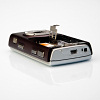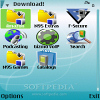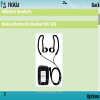The best terminal of the N series, Nokia's high-end lineup, the N95 cannot be compared to any other mobile phone as a whole. Nokia has truly made the first steps towards building a "multimedia computer", just like their officials like to refer to when speaking about their latest additions to the N series. It seems that Nokia managed to design the "Swiss Army Knife" of the mobile phones. The multipurpose device includes all the features you can think of and its market target is only limited by price. Moreover, the phone enables users the possibility to download additional applications offered as freeware or at a low cost if they think the device needs any enhancements.
Announced last fall, the device has been available on the market starting April 2007 at a price that can range between $1,000 and $1,100, depending on the market location.
Design
Nokia N95 is one of the first and the fewest mobile devices that feature a dual-slider design. Is that good or is it bad? First of all, Nokia had a fully bad experience with slider phones with 2 exceptions: Nokia 8800 Sirocco and Nokia E65. The sliding mechanism in slider phones could be considered "Achille's heel" for Nokia. Unfortunately, Nokia N95 is no exception to this and if you already have one of these multimedia computers you'll agree with me that the dual slide mechanism, while innovative, it's not as compact as it should be (see Samsung phones). You must be very careful when carrying your N95 in your pocket, because it could easily slide up/down. One of the good things about the dual slider feature is that it emphasizes the standardized design, but on the other hand, users will now have two "opportunities" to unlock their keys when they actually don't want to.
The exact measures of the device, 99 x 53 x 21 mm, and its weight (120 grams battery included) place Nokia N95 in the medium sized mobile phones category. The right side of the phone gets all the external buttons like: volume control, camera and gallery buttons. The left side of the phone only features the infrared port, 3.5 mm audio output jack and the microSD card slot. There are also two stereo speakers that can be used to listen to the radio or to the music player. On the bottom of the phone we can find the miniUSB port and the small charge port (AC4 adapter). The only thing left is the usual power button which is placed on top of the device. The back of the phone has a deep plum color and bears the Nokia logo and the 5 Megapixel camera that features Carl Zeiss lens.
The keys design looks much the same as Nokia E65, with some minor exceptions. The 5-way control key is flanked only by two other keys: the menu key and the key that controls the multimedia features of the phone. Edging all three are the usual contextual keys found in any Nokia slider. All keys are visible in dark areas through the backlighting system which displays a nice bluish light. The innovative part of the phone reveals when you actually slide down the phone and discover the music keys used for controlling the music player.
And here comes another "buggy thingie": after you slide it down the phone will take you to the multimedia center and at the same time, the background of the display will change to landscape. After you're done with the music and want to slide back the phone, the display's background will remain in landscape mode and the keys will lock. In order to get back to the usual view you need to slide up the phone and then back, which could be annoying.
The phone comes with a whole range of accessories such as: Nokia 3.5 mm earphones, remote control, USB data cable, cable for TV connection, 128 MB microSD card, AC4 charger.
Display and Camera
Nokia N95 features a huge TFT "energy eater" display that supports 16 Million colors and a resolution of 240 x 320 pixels. Don't worry though, as there are some functions that can be set to limit the energy consumption such as: light sensor, power saver time-out and light time-out. There are also six customizable application shortcuts that appear on the display in the active standby mode and another two available when the standby mode is off. You can also customize the font appearance (small, medium or large) and the welcome/logo note.
When you are using the media center, the display will change automatically to landscape mode, but as I explained above, you must slide the phone up again to be able to change back to normal view - one of the best displays that can be read perfectly outdoors when the sun is shining, as well as when it's dark.
The 5 Megapixel monster camera seems to be second to Sony Ericsson's Cybershot. As seen in pictures below, the camera performed very well in all weather conditions. The Carl Zeiss lenses are doing a great job and users will be particularly thrilled to take shots no matter if it's night or day. On the front of the phone, there is the secondary camera used for video calls, but also for taking self-portraits pictures (640 x 480 pixels max. resolution). The camera functions are easy to use and intuitive, especially if you have used a digital camera before. Unfortunately, it takes about 7 seconds to activate the camera which is terribly low, especially if you need to capture something fast.
You can take pictures just as you would do it with a normal camera, click the button halfway until you spot the green square, which means that the camera is focused, and then you can push it till the end and take the picture. The maximum resolution supported is 2582 x 1944 pixels and users can choose to shoot in 5 modes as seen in the pictures.
I personally suggest using the 3 Megapixel mode, as pictures look more than decent without taking too much space for storing. While every phone camera has algorithms built-in, for reducing noise effect by slightly blurring the image and finally sharpen it up, these processing algorithms are built to "please" as many buyers as possible. Nokia N95 uses the same technology to reduce red-eye effect and noise, but lacks a more consistent flash (like xenon flash) and it only features digital zoom. A good receipt for taking good shots with Nokia's N95 camera is an interesting subject, an unflinching hand, good lighting and strong color contrast.
There are no specially created functions for this camera and as you can see from the screenshots they are very easy to use. The same goes for the video camera which can capture clips in MP4 or 3GPP formats, depending on the quality you decide to choose. See the sample at the end of the review for a glimpse of what this little toy can do.
Menu and Software
Nokia N95 runs Symbian 9.2 operating system with S60 3rd Edition and Feature Pack 1 interface. This Pack offers some improvements and adds some new features like an alarm clock, vCalendar 2.0, support for 3D graphics and hardware acceleration, as well as screen turning. The repeated alarm clock offers users the wake up call whenever they want, so they won't need to buy third party applications for that purpose. The main menu can be accessed by pressing the left key right beside the 5-way control key. In addition to the usual options and applications that we meet in almost all Symbian powered handset, Nokia N95 features Search and Maps utilities. Yahoo! and Nokia partnered to implement this new option made available for Nokia N95 buyers. There's a fierce battle going on between Google and Yahoo! Search engines, but Google seems to be winning that by far. So, second only to Google, Yahoo!'s Search utility made its way to Nokia N95 users offering a very handy feature.
The other innovative application for Nokia phones, Maps, is used together with the GPS receiver and enables owners to use Nokia maps, localization and directions when they're on the go. Lots of maps can be downloaded from Nokia's website and can be used for choosing the shortest route from one point to another.
Under the Office category we can find QuickOffice applications used for reading Word, Excel and PowerPoint files. Again, you cannot edit any files without upgrading the application, which of course costs money. There's also a PDF reader, a Notepad, a Zip archivator, a calculator, a currency converter, a voice recorder and a barcode reader. You can also connect a keyboard to the phone by using the Bluetooth connectivity, through the Wireless keyboard application found here. The Applications submenu offers a new and interesting feature called Lifeblog. The application helps bloggers post pictures and information on their blog pages. The Video centre connects the phone to a bigger screen (projector, monitor or TV) through the TV-out cable for a better view of the videos. The phone features only two 3D games, System Rush and Snakes which are making a great addition to the entertainment side.
The Multimedia Centre can be accessed from the right key beside the 5-way control or by sliding down the phone, which will also turn the screen to landscape view. Visual radio, music player, lifeblog, video centre, web, gallery, maps or games can all be accessed from this multimedia centre.
You have everything you need on the road or in the office, pre-installed on the handset: email, web, calendar, organizer, IM, office tools, messaging, applications manager, connectivity wizard, synchronization tools, GPS navigator, themes, profiles and even more. The phone seems to be a complete tool that will satisfy any user that purchases the handset, and if not, you can always install your own software applications compatible with Symbian S60 3rd Edition operating system from our database.
Communication
Nokia N95 is a quad band GSM (850 / 900 / 1800 / 1900) handset, HSDPA compatible that features GPRS class 11 ( 32 - 48 kbps), EDGE 32 class (296 kbps), High-Speed Circuit-Switched Data (57.6 kbps) and Wi-Fi 802.11 b/g. Tested on the EDGE and 3G networks the phone performed a little bit above average as you can see in the screenshots. We have obtained the best results when testing the WLAN network speed. This proves that the phone can actually reach higher numbers on both EDGE and 3G but was limited due to operator's network (Orange).
The WLAN wizard helps you search and define your WLAN network connection settings. If you want to connect to the Internet you must first define an Access point (EDGE, WLAN or 3G). You can do that by going to Main menu ? Tools ? Settings ? Connection ? Access points and define which access point to be used whenever a network connection is required (Main menu ? Home network - Settings).
Other connectivity tools include Bluetooth 2.0 with A2DP support, Infrared and miniUSB port PC synchronization. The Bluetooth connection reached almost 100kbps with ease, so you'll be able to transfer data fast. When connecting the USB cable you'll be able to choose between 4 modes: PC Suite, Data transfer, Image print and Media player. All 4 modes are intuitive and easy to use, so there's nothing more to tell. The phone can also be connected to a modem through the Infrared port or you can choose to add the terminal to a public network and share some content.
Signal reception is very good except when turning on 3G network where results were not at their best.
Processor and Memory
The lastest multimedia computer from Nokia's N series, Nokia N95 features an ARM11 based processor running at 319 Mhz speed but with no Jazelle technology for running Java applications. The phone only features a Just-in-Time Java Compiler which will make your Java software start slower. Unfortunately, the phone froze more than a few times when accessing the Internet through WLAN and some other applications. We had to totally reset the phone to make it work again.
If you think that 160 MB internal memory is enough, then think again. Especially if you're a "heavy" camera user or a music freak. Fortunately, Nokia thought about that and included a microSD slot card that will let you expand the phone's memory up to 2 GB. Overall, we had problems running more applications on the device with numerous freezes and even restarts, which definitely lowers its usability and performance.
Multimedia
Nokia tried but unfortunately it's not what we expected. The music player supports MP3, AAC, AAC+, eAAC+ and WMA files and features an equalizer with a Bass booster and only 4 modes: Classical, Jazz, Pop and Rock. Nokia earphones included are crappy and I strongly advise you to go buy better ones.
The 2 external stereo speakerphones sound pretty good for a phone, but who's gonna use them anyway? Even with better headsets, Sony Ericsson's Walkman series music vibes are by far superior to those found in Nokia N95, but overall, the sound was pretty cool when we used Sennheiser HD 205 model headphones. The Visual Radio offers the option to download a full database with radio stations but it does not feature RDS. You can manually search for radio stations in your country and memorize it on those 50 channels available. Don't forget that the radio is only available if you insert earphones, only then you will also be able to choose to listen to the external speakerphones.
The RealPlayer included supports MPEG4, 3GPP and RealVideo formats. If you want a bigger screen for watching high-quality movies you can use the TV-out cable. The Video centre enables users to connect to a web video archive just like a podcast.
Battery
Nokia N95 features a BL-5F 950 mAh battery which has an official stated life expectancy of 6 hours and 30 minutes in talk time mode and 220 hours in standby mode. As usual, the battery recharge time is almost 2 hours. Unfortunately, the battery is one of the weak points of the phone, "performing" only about 3 hours in talk time. We've intensively tested the phone with Internet surfing, display settings at full, video playback and music player, thus we had to recharge it once at two days. All in all, there's no way that Nokia N95 could ever achieve the official numbers with this type of battery.
Impressions
While Nokia N95 is a multipurpose device and can satisfy most of the mobile phone users? needs, the dual slider design was badly integrated. I can't say that it's a bad idea, on the contrary it's brilliant, but the fact that the phone opens in your pocket makes you wonder if Nokia will ever manage to correct these annoying flaws in slider phones design. The Web surfing experience was excellent, as well as the multitude of Internet related features (Search, Blog, Video centre). Seen as the best phone Nokia has ever launched on the market, N95 didn't disappoint at all and benefits from the latest technologies available in the mobile industry at the moment.
The Good
Internet freaks will be thrilled about the features offered by the handset. Chatting, blogging, searching, email-ing or simply Web surfing makes Nokia N95 a complete Internet solution experienced at the top. All that could not be fully complete without the WLAN connectivity available or the HSDPA compatibility. The 3.5 mm jack is also very useful because users will be able to attach their own headphones. The camera is worth mentioning as it's one of the best on the market in terms of quality but not regarding the speed. Also, the design is interesting but the dual slider thing is poorly implemented.
The Bad
I will only enumerate some of them as the list is pretty long: no USB recharging, crappy earphones, badly dual slider design implementation, poor battery life autonomy, software problems, lack of an office document editor, no RDS for the radio and the list can continue.
Sales package
Nokia N95 handset Nokia 950 mAh battery (BL-F5) 1GB microSD memory card Wired remote control Stereo headphones USB data cable Charger (AC-4) TV-out cable User manual CD software
Photo: Tudor Raiciu for Softpedia.com
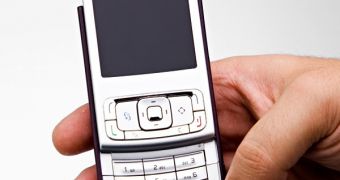
 14 DAY TRIAL //
14 DAY TRIAL // 